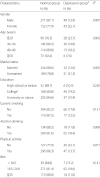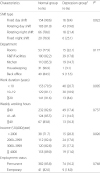1. Härmä MI, Ilmarinen JE. Towards the 24-h society—new approaches for aging shift workers? Scand J Work Environ Health. 1999; 25(6):610–615. DOI:
10.5271/sjweh.488. PMID:
10884161.
2. Costa G. Shift work and occupational medicine: an overview. Occup Med. 2003; 53(2):83–8. DOI:
10.1093/occmed/kqg045.
3. Harrington JM. Health effects of shift work and extended hours of work. Occup Environ Med. 2001; 58(1):68–72. DOI:
10.1136/oem.58.1.68.
4. McMenamin TM. A Time to work: recent trends in shift work and flexible schedules. Monthly Lab Rev. 2007; 130:3.
5. Parent-Thirion A. Fourth European working conditions survey: European Foundation for the Improvement of Living and Working Conditions. 2007.
6. Survey on working hours. Ministry of Employment and Labor. 2011.
http://www.moel.go.kr. Accessed 13 Oct 2014.
7. K-y K, M-s K. A study approach to raising the revisit rate of foreign inbound tourists in Korea : an introduction to the concept of basic tourism environment. Tourism and Leisure Research. 2014; 26(5):5–21.
8. Tourist accommodation business status estimates. Korea Culture and Tourism Institute.
http://www.tour.go.kr. Accessed 02 Apr 2015.
9. Economically Active Population Survey. Statistics Korea.
http://kostat.go.kr. Accessed 13 Oct 2014.
10. Folkard S, Minors DS, Waterhouse JM. Chronobiology and shift work: current issues and trends. Chronobiologia. 1985; 12:31–54. PMID:
3888553.
11. Minors D, Waterhouse J. Circadian rhythms and their mechanisms. Experientia. 1986; 42(1):1–13. DOI:
10.1007/BF01975875. PMID:
3510896.
12. Brown DL, Feskanich D, Sánchez BN, Rexrode KM, Schernhammer ES, Lisabeth LD. Rotating night shift work and the risk of ischemic stroke. American Journal of Epidemiology. 2009;056.
13. Tüchsen F, Hannerz H, Burr H. A 12 year prospective study of circulatory disease among Danish shift workers. Occup Environ Med. 2006; 63(7):451–5. DOI:
10.1136/oem.2006.026716. PMID:
16735480.
14. Lee KJ, Kim JJ. Relationship of shift work to cardiovascular and gastrointestinal symptoms in Korean female workers. Korean J Occup Environ Med. 2008; 20(4):362–71.
15. De Bacquer D, Van Risseghem M, Clays E, Kittel F, De Backer G, Braeckman L. Rotating shift work and the metabolic syndrome: a prospective study. Int J Epidemiol. 2009; 38(3):848–54. DOI:
10.1093/ije/dyn360. PMID:
19129266.
16. Pietroiusti A, Neri A, Somma G, Coppeta L, Iavicoli I, Bergamaschi A, Magrini A. Incidence of metabolic syndrome among night-shift healthcare workers. Occup Environ Med. 2010; 67(1):54–7. DOI:
10.1136/oem.2009.046797. PMID:
19737731.
17. Megdal SP, Kroenke CH, Laden F, Pukkala E, Schernhammer ES. Night work and breast cancer risk: a systematic review and meta-analysis. Eur J Cancer. 2005; 41(13):2023–32. DOI:
10.1016/j.ejca.2005.05.010. PMID:
16084719.
19. Sugisawa A, Uehata T. Onset of peptic ulcer and its relation to work-related factors and life events: a prospective study. J Occup Health. 1998; 40(1):22–31. DOI:
10.1539/joh.40.22.
20. Åkerstedt T, Nordin M, Alfredsson L, Westerholm P, Kecklund G. Sleep and sleepiness: impact of entering or leaving shiftwork-a prospective study. Chronobiol Int. 2010; 27(5):987–96. DOI:
10.3109/07420528.2010.489423. PMID:
20636211.
21. Ohayon MM, Lemoine P, Arnaud-Briant V, Dreyfus M. Prevalence and consequences of sleep disorders in a shift worker population. J Psychosom Res. 2002; 53(1):577–83. DOI:
10.1016/S0022-3999(02)00438-5. PMID:
12127174.
22. Driesen K, Jansen NW, Kant I, Mohren DC, van Amelsvoort LG. Depressed mood in the working population: associations with work schedules and working hours. Chronobiol Int. 2010; 27(5):1062–79. DOI:
10.3109/07420528.2010.489877. PMID:
20636216.
23. Bara A-C, Arber S. Working shifts and mental health-findings from the British Household Panel Survey (1995-2005). Scandinavian journal of work, environment & health. 2009;361-367.
24. Colligan MJ, Rosa RR. Shiftwork effects on social and family life. Occup Med. 1989; 5(2):315–22. PMID:
2203160.
25. Loudoun R, Bohle P. Work/Non-work conflict and health in shiftwork: relationships with family status and social support. Int J Occup Environ Health. 1997; 3(Suppl 2):71–7.
26. Üstün T, Ayuso-Mateos JL, Chatterji S, Mathers C, Murray CJ. Global burden of depressive disorders in the year 2000. Br J Psychiatry. 2004; 184(5):386–92. DOI:
10.1192/bjp.184.5.386. PMID:
15123501.
27. World Health Organization. The World Health Report 2001: Mental health: new understanding, new hope. World Health Organization; 2001.
28. Sanderson K, Andrews G. Common Mental Disorders in the Workforce: Recent Findings From Descriptive and Social Epidemiology. Can J Psychiatry. 2006; 51:63–75. PMID:
16989105.
29. Kessler RC, Aguilar-Gaxiola S, Alonso J, Chatterji S, Lee S, Ormel J, Üstün TB, Wang PS. The global burden of mental disorders: an update from the WHO World Mental Health (WMH) surveys. Epidemiol Psichiatr Soc. 2009; 18(01):23–33. DOI:
10.1017/S1121189X00001421. PMID:
19378696.
30. Kessler RC, Akiskal HS, Ames M, Birnbaum H, Greenberg P, Jin R, et al. Prevalence and effects of mood disorders on work performance in a nationally representative sample of US workers. American journal of psychiatry. 2006; 163(9):1561–1568. DOI:
10.1176/ajp.2006.163.9.1561. PMID:
16946181.
31. Son Y-J, Park Y-R. Relationships between sleep quality, fatigue and depression on health promoting behavior by shift-work patterns in university hospital nurses. J Korean Biol Nurs Sci. 2011; 13(3):229–37.
32. Kim CY, Huh BY. Psychological symptoms analysis of night duty workers by symptom Checklist-90-Revision. Korean J Occup Environ Med. 1989; 1(2):228–35.
33. Nam M, Joe SH, Jung IK, Soh KY, Chung CK. Anxiety, depression and immune functions of shift workers. Korean J Occup Environ Med. 1997; 9(3):478–86.
34. Kim YG, Yoon DY, Kim JI, Chae CH, Hong YS, Yang CG, Kim JM, Jung KY, Kim JY. Effects of health on shift-work: general and psychological health, sleep, stress, quality of life. Korean J Occup Environ Med. 2002; 14(3):247–56.
35. Bae SM, Lee YJ, Kim SJ, Cho IH, Kim JH, Koh SH, Cho SJ. Rotating shift and daytime fixed work schedules as a risk factor for depression in korean police officers. Sleep Med Psychophysiol. 2010; 17(1):28–33.
36. Expert Consultation WHO. Appropriate body-mass index for Asian populations and its implications for policy and intervention strategies. Lancet. 2004; 363(9403):157–63. DOI:
10.1016/S0140-6736(03)15268-3. PMID:
14726171.
37. Spurgeon A. Working Time: Its Impact on Safety and Health: International Labour Office. 2003.
38. Cho MJ, Kim KH. Diagnostic validity of the CES-D (Korean version) in the assessment of DSM-III-R major depression. J Korean Neuropsychiatr Assoc. 1993; 32(3):381–99.
40. Cho JJ, Kim JY, Chang SJ, Fiedler N, Koh SB, Crabtree BF, Kang DM, Kim YK, Choi YH. Occupational stress and depression in Korean employees. Int Arch Occup Environ Health. 2008; 82(1):47–57. DOI:
10.1007/s00420-008-0306-4. PMID:
18301911.
41. Chu S, Ryou H, Bae K, Song J, Lee S, Kim I. Association between emotional labor and symptoms of depression among bankers. Korean J Occup Environ Med. 2010; 22(4):316–23.
42. Kim HJ, Kim JH. Emotional labor, social support, and depressive symptoms of clinical nurses in a province, Korea. Korean J Occup Health Nurs. 2011; 20(3):308–18. DOI:
10.5807/kjohn.2011.20.3.308.
43. Meltzer H, Bebbington P, Brugha T, Jenkins R, McManus S, Stansfeld S. Job insecurity, socio-economic circumstances and depression. Psychol Med. 2010; 40(08):1401–7. DOI:
10.1017/S0033291709991802. PMID:
19903366.
44. Weissman MM, Bland RC, Canino GJ, Faravelli C, Greenwald S, Hwu H-G, Joyce PR, Karam EG, Lee C-K, Lellouch J. Cross-national epidemiology of major depression and bipolar disorder. Jama. 1996; 276(4):293–9. DOI:
10.1001/jama.1996.03540040037030. PMID:
8656541.
45. Koo JW, Lee SH. Industrial fatigue due to banking operations with VDT. Korean J Prev Med. 1991; 24(3):305–13.
46. Koh SB, Son M, Kong JO, Lee CG, Chang SJ, Cha BS. Job characteristics and psychosocial distress of atypical workers. Korean J Occup Environ Med. 2004; 16(1):103–13.
47. Lee JJ, Moon HJ, Lee K-J, Kim JJ. Fatigue and related factors among hotel workers: the effects of emotional labor and non-standard working hours. Ann Occup Environ Med. 2014; 26(1):1–10. DOI:
10.1186/2052-4374-26-1. PMID:
24472308.
48. Chun H, Son MA, Kim Y, Cho E, Kim J, Paek D. Effect of shift work on worker's health, family and social life at a automobile manufacturing plant. Korean J Occup Environ Med. 1998; 10(4):587–98.
49. Åkerstedt T. Shift work and disturbed sleep/wakefulness. Occup Med. 2003; 53(2):89–94. DOI:
10.1093/occmed/kqg046.
50. Wight VR, Raley SB, Bianchi SM. Time for children, one's spouse and oneself among parents who work nonstandard hours. Social Forces. 2008; 87(1):243–71. DOI:
10.1353/sof.0.0092.
51. Verhaegen P, Cober R, SMEDT MD, Dirkx J, Kerstens J, Ryvers D, DAELE PV. The adaptation of night nurses to different work schedules. Ergonomics. 1987; 30(9):1301–9. DOI:
10.1080/00140138708966024. PMID:
3428255.
52. Folkard S. Do permanent night workers show circadian adjustment? A review based on the endogenous melatonin rhythm. Chronobiol Int. 2008; 25(2-3):215–24. DOI:
10.1080/07420520802106835. PMID:
18533325.
53. Wong IS, McLeod CB, Demers PA. Shift work trends and risk of work injury among Canadian workers. Scand J Work Environ Health. 2011;54-61.
54. Barton J. Choosing to work at night: a moderating influence on individual tolerance to shift work. J Appl Psychol. 1994; 79(3):449. DOI:
10.1037/0021-9010.79.3.449. PMID:
8034558.
55. Lee ES, Kim K, Song HJ, Lee JS, Kim SY, Lee HS, Choi J. Comparison of job satisfaction and nursing performance between nurses on fixed nights and nurses on three shifts, and nurses understanding of fixed night shift system. J Korean Clin Nurs Res. 2012; 18(1):63–73.









 PDF
PDF Citation
Citation Print
Print


 XML Download
XML Download